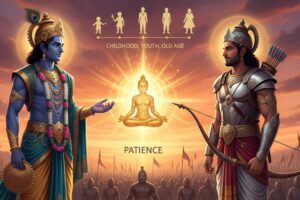
Para-Apara Vidya,Sanskrit & Psychology
- Posted by Sri Kameswari Foundation
- Date June 9, 2025
- Comments 0 comment
In our second episode,we try to understand the following:
Para Vidya and Apara Vidya
The word Vidya comes from the Sanskrit root “vid”,which means “to know” or “to understand.” The word Para refers to that which is transcendent,supreme or ultimate.Hence,Para Vidya refers to the knowledge of the Supreme Self.
The Vedas,Upanishads,Brahma Sutras and similar texts are considered Para Vidya,as they offer direct knowledge of Brahman.
All other systems of knowledge that do not directly address Brahman are termed Apara Vidya—this includes various derived sciences, technologies, and other disciplines.
Our current text,the Śrīmad Bhagavad Gītā,falls under Para Vidya,as it is the Supreme Being—Bhagavān Śrī Kṛṣṇa—who speaks about Himself in this profound Vedantic scripture.
Reading of Sanskrit Shlokas
It is the great fortune of Sanātanīs that they can more easily understand Sanskrit,as most Indian languages have their roots in it.If one is well-versed in their mother tongue,they can often grasp the essence of Sanskrit shlokas with relative ease.
To begin understanding a shloka,one should recite it slowly,word by word,several times.With repeated chanting and reflection,the meanings of the individual words and the overall message begin to unfold naturally.
Behavioral Science / Psychology
When we refer to Bhāratīya scriptures,we recognize them as profound sources of knowledge that encompass every dimension of human life.These texts not only identify the challenges one may face but also offer well-articulated solutions rooted in experiential wisdom.
They may rightly be considered early works in behavioral science,offering deep insights into the psychology of human beings across varied circumstances.The Śrīmad Bhagavad Gītā is a prime example of such a scripture,wherein a range of behavioral patterns and psychological states are discussed in depth.
For instance,when an individual experiences depression or emotional turbulence,psychological imbalances manifest as noticeable behavioral changes—such as diminished energy,a sense of helplessness,or an inability to manage situations that were previously handled with ease.
Similar patterns are seen in Arjuna,who,upon witnessing his kith and kin arrayed on the battlefield of Kurukṣetra,exhibits signs of deep emotional distress and psychological breakdown. These symptoms are vividly described in the first chapter of the Gītā.
By studying these verses,one is encouraged to introspect and identify similar states within oneself,and to draw strength from the guidance offered by Bhagavān Śrī Kṛṣṇa to Arjuna.
It is for this reason that the Bhagavad Gītā retains timeless relevance—not only as a spiritual text but also as a psychological guide for humanity.
This post covers the concepts related to the second episode. Please click on the “Ch-1|Meaning of Shlokas 26-30” link in the Śrīmadbhagavadgītā Tattvamu home page to read the meaning,that has been explained in Episode-2.
You can also listen to this in Telugu from our Āchārya,Dr. Jammalamadaka Suryanārāyaṇa garu,by clicking the video below.
You may also like

Pratyabhijna,The Deeper Meaning of Antaha,Atma Tattvam

Ch-2|Meaning of Shlokas 15-17

